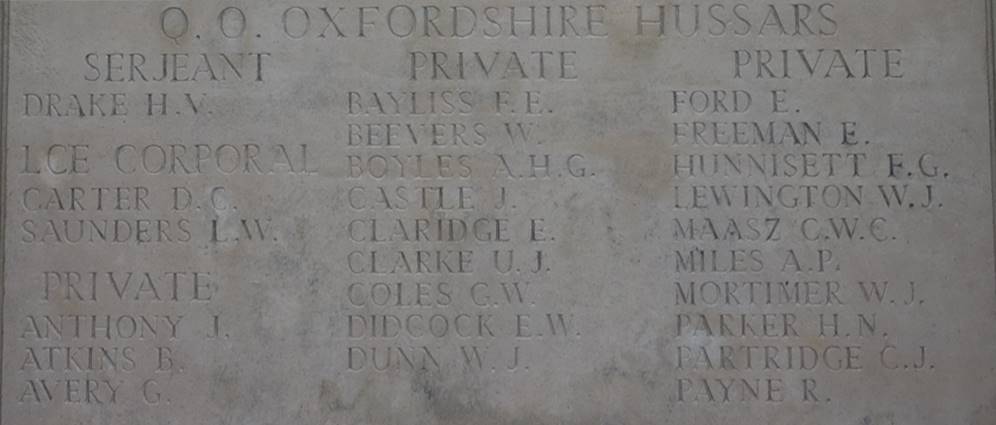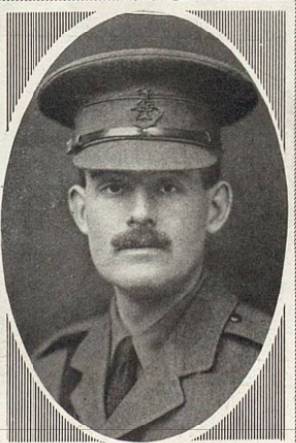This article is about the Queen’s Own Oxfordshire Hussars and will help you to research the Regiment and those who served with it during the First World War. This article is one of a series I have written to help you research soldiers who served in the First World War:
The Queen’s Own Oxfordshire Hussars in the First World War
This article is about the Oxfordshire Yeomanry which in 1914 had its headquarters at Oxford and recruited its four squadrons from the surrounding area. During the war, the Regiment raised a Second (2nd/1st) and Third line (3rd/1st) regiments which have left few records. There is a two page appendix covering both in the regimental history which I have discussed below.
In August 1914, the Queen’s Own Oxfordshire Hussars was part of the 2nd South Midland Mounted Brigade along with the Bucks, and Berkshire Yeomanry and a variety of supporting units. The Regiment was mobilized on the outbreak of war and landed in France in September 1914. The Oxfordshire Yeomanry was the first Territorial Force unit to depart for France though it arrived after the London Scottish (14th Battalion, London Regiment) and the Honourable Artillery Company. The Oxfordshire Yeomanry did hold the distinction of being the first Territorial Force unit to come into action.
In October 1914, the Regiment joined the 2nd Cavalry Brigade, 1st Cavalry Division but its service was short-lived as in November 1914 the Regiment was transferred to the 4th Cavalry Brigade, 2nd Cavalry Division. The Regiment served on the Western Front for the duration of the First World War.
How to Research Soldiers who Served in the Oxfordshire Hussars
The first step I would recommend is looking at my research guides to Researching WW1 Soldiers which will help you find medal and service records. Your next steps would be:
- Download the Oxfordshire Hussars’ War Diary (see below)
- Get hold of a copy of The Oxfordshire Hussars in the Great War by Adrian Keith-Falconer which I have discussed below
Officers: Usually very easy to research and prior to the outbreak of war they were drawn from the local Oxfordshire gentry. First, check for a service record at the National Archives. If an officer continued to serve past April 1922 then service record will still be with the MOD. Officers are mentioned throughout the Oxford Yeomanry’s war diary and regimental history. The Regimental history also contains a list of officers who served with the Oxfordshire Hussars, along with appendices of officers who became casualties and received decorations.
If you’re after a photograph of an officer, then The Sphere, The Tatler, Illustrated London News are good places to start. I have written a guide to help you: Researching Soldiers Using Newspapers.
Major Valentine Fleming Oxfordshire Hussars who was killed in action in 1917. Valentine Fleming was the father of Ian Fleming the creator of James Bond.
Other Ranks: A service record is really the key document to find as other ranks are a lot harder to research compared to officers. Unfortunately, many were destroyed in the Blitz. If a soldier served past January 1921 then this record is still kept by the MOD. The regimental history contains a complete list of casualties, killed, wounded, prisoner suffered by the Oxfordshire Hussars as well as a list of other ranks who were decorated. The casualty list contains the soldier’s regimental number, rank and name, date of wound and place/battle. Like officers, a newspaper search is always worthwhile: Researching Soldiers Using Newspapers. A date of enlistment in the regiment can often be worked out if no service record has survived from a soldier’s regimental number.

War Diary of the Oxfordshire Hussars
There is one war diary for the 1/1 Oxfordshire Hussars which has been digitized and can be downloaded for a small fee from the National Archives’ website. There is also a small war diary for the 2/2 Oxfordshire Hussars which hasn’t been digitized and can only be viewed at the National Archives.
- Date: 01 August 1914 – 20 May 1919
- 4th Cavalry Brigade, 2nd Cavalry Division
- Reference: WO95/1137/2
- Notes: An average war diary at best which is why the regimental history is so useful. The only appendix is a typed account of a raid conducted on 24 July 1917 which I have transcribed below.
- Date: October 1915 – February 1916
- 2/2 South Midland Mounted Brigade, 2nd Mounted Division
- Reference: WO95/5461
- Notes:
Further Sources for the Queen’s Own Oxfordshire Hussars
The most important resource to get hold of if you wish to know more about the Regiment is The Oxfordshire Hussars in the Great War by Adrian Keith-Falconer. This book is crammed full of useful information and names. Fortunately, this book has been reprinted by the Naval and Military Press and you can buy a copy online. The book contains an appendix which records all the casualties of the Regiment including wounded with their regimental number and date the casualty occurred.
Extract from the War Diary of the Oxfordshire Hussars
Report by 4th Cavalry Brigade of Raid Carried out by “C” Squadron Oxfordshire Hussars, 12.30 am July 24th [1917]
The hour of zero was 12.30 am July 24th. The preliminary bombardment was short and intense, it was started at 12.30 am July 4th, and lifted at 12.35 am, at which hour the two parties B and E were due to enter the trenches.
B Party consisted of 2 N.C.O’s and 15 O.R’s [Other Ranks]
E Party consisted of one Officer, 1 N.C.O. and 15 O.R’s.
The above numbers included signallers R.E’s etc. Both parties had crawled forward 1/4 of an hour before zero to positions of readiness opposite their objectives; and as the guns opened advanced forwards toward the enemy. To take the action of each patrol in detail:
B Patrol: As the patrol moved forward the leader found the wire in front of the enemy’s first trench uncut, the two R.E. men with the torpedo at once blew the wire up (in was only one knife rest thick) and the party crossed the trench, it was three feet deep, and blown in; here they dropped a flanking party to watch their right flank; and then advanced towards the second trench.
They found our bombardment had destroyed the enemy wire and they entered the trench without difficulty, the leader of the party here ordered two of his men to return to the first enemy trench which they crossed, and these two men on their way back found 7 of the enemy by the hedge, a bombing fight ensued, two of the enemy were killed, and four ran towards the farm and were lost; the last however, showed fight, and had to be shot, this was done, and he died within a minute or two, before anything could be got out of him.
The remainder of patrol moved on, and passed round the island where they found 2 dead men on the right hand side; they also found a small dug out, it was empty ecept for one man’s kit. A German was also seen down one of the trenches; but he ran away at once. Away on the right a party of about 12 Germans was seen, but before they could be taken on, a Trench Mortar Bomb landed in the middle of them and they vanished.
As much damage was done to the enemy trenches and wire, as was possible, and as time was now up; the party returned with the kit they had found, unmolested and without casualties. They were lucky enough to find that the enemy had laid out his kit as for an inspection, this rather lighted their task of obtaining identifications. It seem possible that the garrison were about to be relieved, and were waiting to march out.
E Patrol: The Trench Mortar fire, which was trying to cut the wire in front of this party, fell rather short, and at first hampered their movements to some extent. They found the German wire uncut; and the R.E brought forward a Bangalore torpedo; it failed to explode, a second was brought up, it exploded and also detonated the first, an excellent gap in the wire was the result. While all this was going on, the enemy bombed & fired at the patrol, the 2nd in command & 4 men were hit.
In spite of the enemy fire at close range the remainder carried on. The gap made, the patrol entred the trench, the Officer in command was now wounded. The command then developed on a young L/Corporal who took charge, reorganised the party, and continued the raid with determination. About 7 or 8 Germans ran down the left of the trench; two Oxford Hussars chased them, but the enemy got out of the trench where it was blown in and ran away cross country. The trench was searched but no live enemy found.
The patrol now advanced towards the second trench. They were however held up by wire, which was uncut. Their time was now up and they, therefore, had to withdraw. This was successfully accomplished all of the wounded were brought back, and the rest of the patrol returned bringing with them some enemy kits.
The total casualties were 1 Officer, and 5 O.R’s wounded.
The enemy’s retaliation was not heavy, and all those taking part in the raid were safely withdrawn to reserve area. Our bombardment slowly died down after Zero plus 20 minutes.

